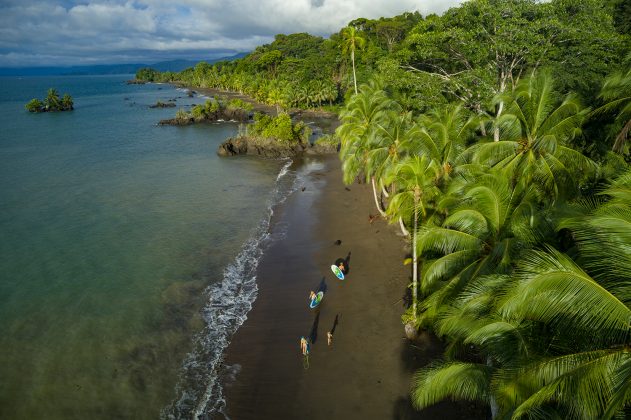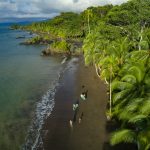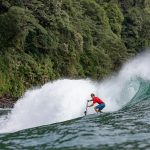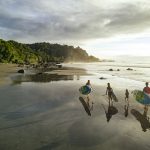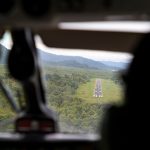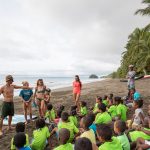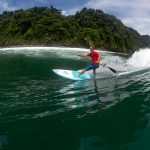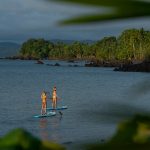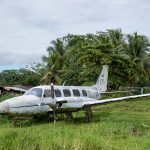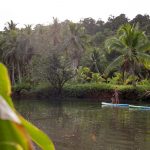COLUMBIA
Words Manu Bouvet // Photos Pierre Bouras
For their eco-ride series “The Green Wave”, Carine and Manu and their two daughters went on a trip to document an inspiring new initiative: in the Chocó region of the Pacific coast of Colombia, surfing has become a form of therapy as a means to heal young kids’ traumas from often violent pasts. They discovered a project that goes right to the heart of the community.
You can’t walk far with Nick Reeves on the sandy streets of Termales without him calling out to one of the kids or them coming up to him.
Despite loud Reggaeton blasting from the stereo, you can hear the conversation:
“Hi Camilo, how are you? You got back from school ok? How did the river crossing go with this high tide?” “Hernan, tell your brother we are expecting him tomorrow at 3pm for the surf lesson” “ Hey Nick, can you lend me a board for tomorrow’s class? Last week I only rode one wave”. He ends the conversation with a dab, immediately reciprocated by his young friend. Nick is originally from South Africa. A high school principal in Medellin, as soon as he has time off, he heads to the Pacific Coast to act as a counselor for the Buen Punto Foundation. Its mission is to offer life opportunities to young Columbian kids through sport. Right away he clarifies: “Forget everything you have read or heard about this city or even this country in general. You be your own judge. But isn’t that why you are here in the first place?”
Few countries in the world evoke violence and drugs the way Colombia does. I’m reminded once more as we land in the middle of the jungle on the tiny runway of Nuquí, capital of Chocó. “Do you think I can ask Uncle Pablo for some vitamins for when I’ve surfed too much?” exclaims my 12 year old daughter Lou, in a big burst of laughter.
“What a start!” I tell myself… Even though we try to communicate with our daughters like adults regarding the situations of the countries we visit, I’m speechless.
Pablo Escobar’s popularity (although dead in 1993), as the bloodiest drug dealers in history, is not limited to his hometown of Medellin’s dicey neighborhoods, but extends all the way to Maui’s middle schools!
Nick has the soul of a teacher although seeing him walking around town the way he does, you would think he was on a campaign. But he’s the kind of person who will drop any activity on the spot, and walk a kid 3km just to make sure he attends school. Here in the Chocó region, surf is an integral part of that. Last month a group of kids from town took a surf trip to Costa Rica, paid for by the foundation. “I fell in love with this region the first time I visited. The waves can be perfect, but it’s really for the people that I come back here and to help with the progress of surf therapy, because the results are tremendous” Nick tells me with enthusiasm. We wander around the tiny town. The colorful wooden shacks are caught between the vast ocean on one side and impenetrable rain forest on the other.
With 10,000mm of annual rainfall (for comparison, Brittany, France has 1,000mm) the Chocó region is the most humid in the world. Entangled in this dense jungle, the population, most of whom are Afro-Colombian, has one of the lowest living standards in the country. Given its inaccessibility and its high poverty rate, this isolated region was the ideal breeding ground for violent and illegal activities of all sorts. It’s in this very jungle that the war went on for almost 50 years, until a peace treaty was signed on August 24th 2016 (for which the Colombian President Juan Manuel Santos was awarded the
Nobel Peace Prize) between the far right paramilitary forces and the far left rebel groups (FARC). Control over cocaine trafficking and access to gold mines to finance the guerrillas were at the heart of this conflict. These years of violence left a deep impact on most Colombians as the conflict spread to the majority of the country. Yet, this region is mostly neglected by the Colombian government due to its isolation and ethnic characteristics.
Today the area is pacified and the army is ubiquitous. I notice it the very next day as we are participating in the surf lesson. I spot a young soldier, in camouflage clothing, machine gun slung over his shoulder sitting under a coconut tree, watching the scene unfold. In front of him, about forty kids, as many girls as there are boys, cheerfully take turns sharing a dozen surf boards. The two Bic surf boards that we brought for the club instantly turned us into local celebrities. Places are dear but everyone will get their turn. Carine is in charge of a small group of girls while Lou helps smaller children in the waves.
Following the customary introductions, I ask the soldier, “do you surf?”
“No… but I would like to! I’m originally from the suburbs of Carthagena, on the Caribbean coast. The waves there aren’t like these, but I like watching the lessons and the work the foundation does.” “What do you like about it?” I ask, a little surprised.
“Well, I believe what you are doing with these children is much more effective than what we do, ourselves. Our presence deters the armed groups from settling here or recruiting in the area, but once we are gone there will be no guarantee… while the values of what Buen Punto teaches through the practice of surfing are here to last! These kids dream of being part of the next group that will compete on the Caribbean coast or in Costa Rica! Can you imagine what an opportunity that is? They have a goal, they are not going to get involved with the paramilitary or set off for the ‘pesca blanca’!”
“What is this ‘white fishing’ “ I ask, perplexed.
“When traffickers are searched with a load of cocaine on board a boat, they throw it all overboard. Some people specialize in fishing after it because of the big payoff”.
After the lesson, as the kids are rinsing off these precious boards, Terjin invites us over to his house. He’s 26 years old and supervises this activity for the foundation. He introduces us to his family, in front of his turquoise wooden shack facing the ocean. They all share this modest home: his mother, nephew and grandmother are chatting on the door step, comfortably seated in rocking chairs. Terjin invites us in. He opens the door with a “Casa Surf” sign on it. Right away I notice surf pictures hanging on the wall, one of them stands out from the others – a guy doing a powerful mid-face turn in front of a hollow section. In the background, a small rocky island covered in jungle extends from a forest that seems to dive into the sea. It’s the type of image that’ll make any surfer want to pack his bags. I don’t have to press Lou to speak Spanish:
“Donde esta? Yo quiero ir!” (Where is it? I want to go!) Lou says to Terjin, all excited.
The million-pesos question you never ask a local. Unless you’re 12 years old, I think to myself, looking at Terjin.
“I’ll take you there as soon as the swell hits, but cuidado (watch out) Lou, because it’s a powerful wave and a 45 minute boat ride to the nearest town.”
“And who is it in the picture?” I ask. I immediately realise this was not the question to ask. Terjin tenses up, his calm smile disappears. “Surfea muy bien! El va a venir con nosotros?” (He surfs really well! Is he going to come with us?) adds Lou, not aware of the silence she breaks with her spontaneity.
“That’s Eduwin, the best of us” Terjin answers finally in a calm voice, as if muffled by the darkness of this room with no electricity. “A few months ago he went through a rough patch, and went off to Medellin to party… he must have met the wrong people and enrolled in the paramilitary, we haven’t seen him since…He surfed this wave like nobody!” he stops, visibly troubled, almost as if feeling some guilt. Outside you can hear the agitation of the kids bringing the boards back to the racks. He’s instantly brought back to the reality of the present moment. “This is the reason why I work with Buen Punto and all these kids, to prevent this from happening. We strongly impress on the values of sports: equality, respect, inclusion, responsibility and trust, as well as other values proper to surfing, such as humility towards the elements and respect for the environment. In this way, we establish a dialogue with the kids in order to repair the past and prepare for the future, laying healthy and solid foundations”.
Places are scarce to represent the Chocó Surf Club at the national championship in Baranquilla. Even more so to go to Costa Rica. First you must have a good school attendance record, which means a 3km walk on the beach from town. At high tide, the kids need to cross two rivers as deep as their necks, and the smaller ones have to swim. Not to mention the crocodiles who like to hang out on the riverbanks when the weather is nice. Finally, you must come home with grades and excel at surfing! Given the number of boards available compared to the number of candidates, whoever picks up a bag full of plastic trash is most likely to have a board at the next lesson. As a result of this initiative, so many bags of plastic trash were piling up that the foundation had to implement a system of waste collection and treatment that till now didn’t exist in the region. So once a week, the taxi boat serving the nearby towns collects the trash to bring it to Nuqui. A waste management center was created!
The trash is then transported by boat and road to a waste recovery company in Medellin. To fully understand the viability of such a project, we followed the weekly collection to Nuqui. Shadé and Lou, like ourselves, carry a bag of bottles under the blazing sun: “Why do we always have to go to a dump when we are traveling? Last time in São Tomé it smelled really bad!” grunts Shadé. “Because we embrace local customs, especially when they are positive. So we pick up plastic bottles in order to go surf. That’s how it works here.” is the first answer that comes to mind.
Fawel greets us in the middle of huge pile of bottles and cans “so, are you ready for the next swell? As a thank you for your help, the Club is going to take you to our favorite spot. You’ll have a blast!” The mention of this long-awaited session gives Lou a burst of energy and she sets both her and her sister’s bags next to the new ‘compactadora’ which is Fawel’s pride and joy. “We used to do it all by hand, it was such a pain, but now, thanks to this machine, it’s much faster. But this works only because we found a way to recycle. Because we buy the bottles, the community plays its role in collecting them. Then I sell the waste to a factory that transforms it and gives it a second life. The virtuous circle is complete.”
We had already noticed in São Tomé and Principe that when the virtuous circle of recycling waste is in place, there is hope of seeing less trash end up in our oceans. As we face reality against the utopian dream of clearing the oceans of all its trash, initiatives focus on the real solution: prevent trash from reaching our oceans either by limiting production (therefore consumption) or by recycling it.
Like almost every other night, a storm rolled in. The sky was ripped apart before unleashing raindrops as big as our hands. Ripped by lightning that seemed to be aiming at our house, it had turned to an unusual pristine blue by dawn. A few scattered stars hold the fort until the sun appears above the drenched jungle. The panga found by Terjin is waiting for us on the shore, Lou can wait no longer. There’s no sign of swell yet… Camilo is part of this trip, coveted by all the kids around here. His grades are perfect, he hasn’t missed a day of school and his commitment to the younger kids is irreproachable. Good thing he has ears to restrain his smile!
“It’s really rare for us to get to surf this wave. It happens from time to time, thanks to the rare visitors such as yourselves.”
The panga slowly makes its way along the coast on glassy waters. Clouds of mist form giant webs in the background, from which the jungle can’t seem to disentangle itself. We pass a headland, the coast is now facing south. The water sprays upwards against the rocky shore. Terjin and Camilo’s eyes light up. Moments like this one are part of the reason I travel, because the best wave is always the next one, just as the best trip is yet to come.
I instantly recognize the scenery from the picture we saw at Terjin’s, with the small island straight out of the planet of the apes. The surroundings are impressive, the jungle almost intimidating, covering everything beneath it. The waves seem to be protecting the sea from an incoming invasion of trees. I feel privileged as I contemplate these wild forces of nature, where mankind has not yet imposed his will. A beautiful left unfolds impeccably over a 100 meters before ending its course on the rocks, where huge liana cling as if they were trying to prevent the canopy from flying away. It’s 6ft on the sets and our little French-Hawaiian-Colombian group seems to be all alone in the world. In rhythm with the sets, dozens of majestic pelicans fly above us, forming a V, a silent air patrol. We must have won something to be blessed with such a tribute! At the peak, Terjin says to me in his calm voice: “You know what hermano, I have a feeling we have all deserved this magical session, so we must honor it and enjoy it to the max. So Vamos!” SUP International
For more info:
The Green Wave on Youtube : Emmanuel Bouvet
Instagram @carinecamboulives & @loubouvet
https://fundacionbuenpunto.org
Thanks to:

